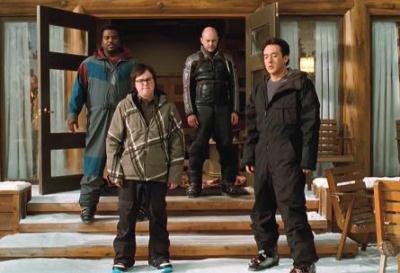Hot Tub Time Machine, 2010, directed by Steve Pink, from a screenplay by Josh Heald and Sean Anders & John Morris.
Some films suggest their own marketing campaigns by having a simple, easy to communicate concept. Take L'Avventura, for example: a woman is missing. There's your premise, there's your trailer, there's your Super Bowl ad, and everyone in marketing can take the rest of the day off, 'cause they're fucking geniuses. But sometimes it's not that simple. Some films can't be reduced to a 30-second spot. How, then, to convince an audience to do the necessary intellectual work to understand a complex, multifaceted work? How can one sell art? This was the challenge that MGM faced with Steve Pink's brilliant, personal film, Hot Tub Time Machine.
Like all great films, Hot Tub Time Machine invents its own cinematic grammar, one that perfectly suits its moving tale of love, loss, and Hot Tub Time Machines. Pink favors wide angles, arranging his actors in flattened, stark tableaus, as though space, like time, is being compressed by some sort of hot tub. Here are Craig Robinson, Clark Duke, Rob Corddry, and John Cusack in a typical example:

Notice the precise camera placement, keeping the Hot Tub Time Machine out of frame. This is a POV shot, but the point of view in question is not that of a character, but of the Hot Tub Time Machine itself. Its unrelenting gaze pins the actors to the ground with the weight of their past failures.
Pink doesn't only implicate his characters in the film, however, and this is where Hot Tub Time Machine distinguishes itself from other films about Hot Tub Time Machines. Consider the virtuoso tracking shot through the ski lodge, where, in turn, a parade of wraithlike characters turn their accusing glare directly at the viewer.

You! they seem to be saying: You are responsible for the sins of this era. You wore the clothes! You voted for Reagan! And no Hot Tub Time Machine can alter the inexorable series of catastrophes your actions have set in motion! It's bone-chilling.
Western art has few works with such a rich and complete texture: every frame rewards careful, extended attention. Hot Tub Time Machine creates its own world. For weeks after seeing it, you will find yourself in a state of heightened perception. And for the rest of your life, every decision will be informed by Hot Tub Time Machines: Nietzsche's eternal recurrence at 100 degrees Farenheit. So it's only natural to wish to communicate that experience to readers: the cottage industry in books about Hot Tube Time Machine and Hot Tub Time Machines is no accident. Yet no collection of words, no ink on a page or pixels on a screen can ever approach the enormity of the film itself. As Adorno put it, writing criticism after Hot Tub Time Machine is barbaric. Indeed, since the Hot Tub Time Machine is itself present at all times, all criticism is barbaric. So there's nothing more I can say on the matter: those that have seen Hot Tub Time Machine know, and those that haven't seen Hot Tub Time Machine can never understand. If anyone needs me, I'll be in the living room watching Snakes on a Plane.
Randoms:
- I actually really enjoyed Hot Tub Time Machine and encourage you to see it. After a couple of drinks.

